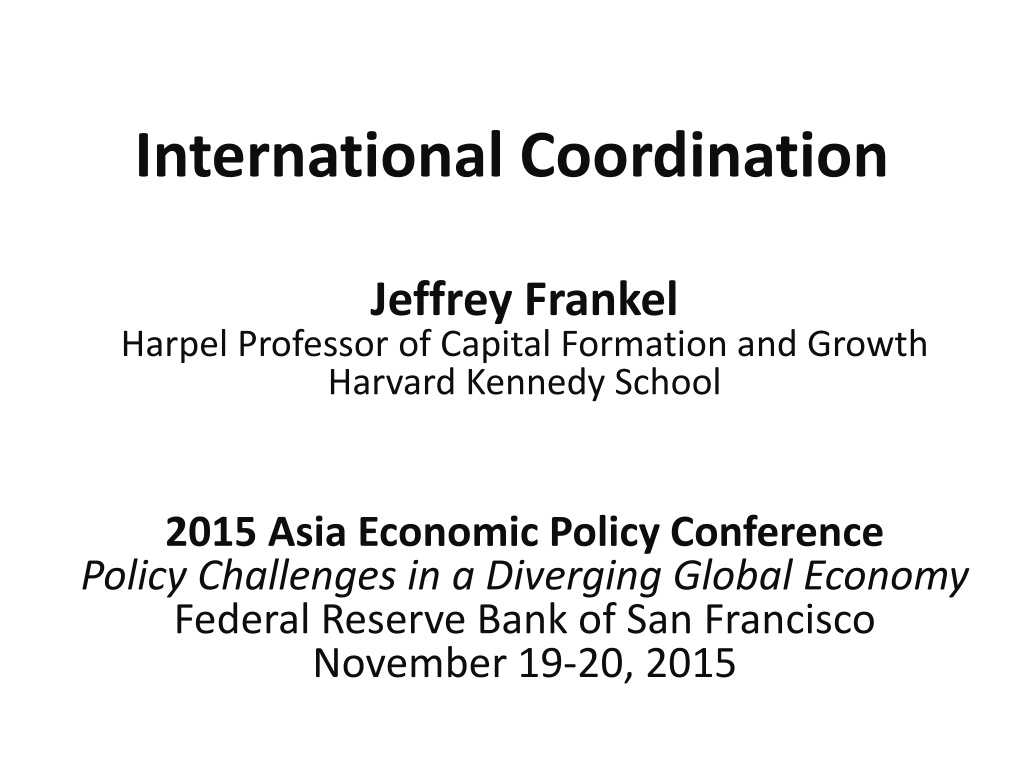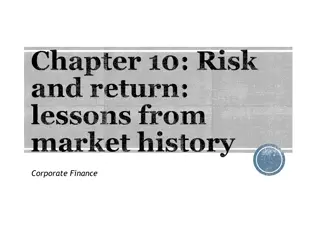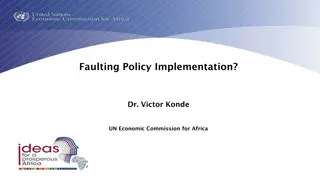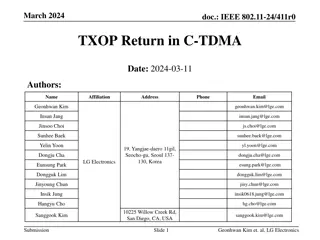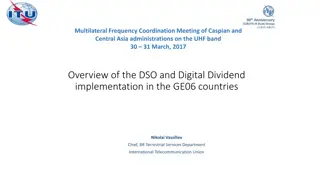The Return of International Policy Coordination: Challenges and Opportunities
Calls for international macroeconomic policy coordination are resurfacing after a 30-year hiatus, with discussions on the evolution of coordination, reasons for its decline, and the revived interest in G-20 summits. Scholars and policymakers are exploring various frameworks for coordinating fiscal and monetary policies amid global economic challenges and uncertainties.
- International policy
- Macroeconomic coordination
- Global economy
- G-20 summits
- Fiscal and monetary policies
Download Presentation

Please find below an Image/Link to download the presentation.
The content on the website is provided AS IS for your information and personal use only. It may not be sold, licensed, or shared on other websites without obtaining consent from the author. Download presentation by click this link. If you encounter any issues during the download, it is possible that the publisher has removed the file from their server.
E N D
Presentation Transcript
International Coordination Jeffrey Frankel Harpel Professor of Capital Formation and Growth Harvard Kennedy School 2015 Asia Economic Policy Conference Policy Challenges in a Diverging Global Economy Federal Reserve Bank of San Francisco November 19-20, 2015
Calls for international macroeconomic policy coordination are back after a 30-year absence. Origins in scholarship: Cooper (1969) and Hamada (1976). Heyday of coordination in practice: the decade 1978-1987, from the Bonn Summit to the Louvre Accord.
Calls for international macroeconomic policy coordination are back Coordination then fell out of favor. Historically, The Germans, in particular, regretted what they had agreed at the Bonn Summit: reflation turned out to be the wrong objective in the inflation-plagued late 1970s. Most summit communiques had little effect, for better or worse. Another problem: the structure of the G-7 did not allow a role for EM countries. Skeptic scholars: Oudiz & Sachs (1984), Rogoff (1985), Tabellini (1990), Kehoe (1987), Feldstein (1988), Fischer (1988), Frankel (1988), Ghosh & Masson (1988).
The return of international policy coordination G-20 leaders summits 1stsummits: DC, Nov. 2008, & London, April 2009, to deal with GFC. Agreements to refrain from competitive depreciation Ceasefire, G-7 ministers in February 2013 Side agreement to TPP, November 2015. EM calls for FRB to coordinate, after taper tantrum of 2013 RBI Gov. Rajan: International monetary cooperation has broken down The U.S. should worry about the effects of its policies on the rest of the world (1/30/14).
The return of international policy coordination This time the issues go by names like currency wars, taper tantrums, and fiscal compacts. Some scholars have returned to the subject: E.g., Blanchard, Ostry & Ghosh (2013), Ostry & Ghosh (2013), Subacchi & Van den Noord (2012), Taylor (2013) and Engel (2014, 2015). And to the question whether floating exchange rates insulate: Rey (2015)
Outline Four possible frameworks for proposals to coordinate fiscal or monetary policy: 1) the locomotive game ( exporting unemployment ), 2) the discipline game (moral hazard), 3) the competitive depreciation game ( currency war ) 4) and the competitive appreciation game ( exporting inflation ). The paper also considers claims that monetary coordination has been made necessary by the loss of the short-term interest rate instrument. Proposals for the direction of coordination vary widely, due to different models and different domestic interests. These differences weaken the calls for coordination which can deflect attention from dealing with important domestic issues.
FISCAL POLICY 1) The locomotive game (as seen, esp., by US): When cooperation means joint expansion Historical examples: G-7 London Summit, 1977; Bonn Summit, 1978 to promote recovery from 1975 recession. G-20 leaders summit in London, April 2009 to deal with GFC. G-20 meeting in Brisbane, November 2014 after a new slowing of global growth. It agreed to strengthen policy cooperation, including to boost demand and jobs.
When cooperation means joint expansion Table 1: The locomotive game US pursues contractionary fiscal policy Non-cooperative beggar-thy-neighbor equilibrium: global recession. US pursues expansionary fiscal policy Europe pursues contractionary fiscal policy US runs trade deficit; complains on behalf of its exporters and import- competing firms. Europe pursues expansionary fiscal policy Europe complains, on behalf of its exporters and import-competing firms. Cooperative locomotive outcome: nobody achieves a trade surplus, but higher spending lifts all boats.
Figure 1: The locomotive game = US spending = German spending
But thats not how the Germans see it 2) The discipline game When cooperation means joint fiscal rectitude In their view, Fiscal expansion is not expansionary. E.g., AS is vertical. And one country s fiscal expansion is a negative externality, not a positive one: competing for funds in global marketplace e.g., Chang (1990); or gambling on bailout in the event of fiscal crisis E.g., from IMF or fellow members of a European Monetary Union e.g., Glick and Hutchison (1993), Aizenman (1998). For that matter, it s not how US congressional Republicans see it either.
Table 2: The discipline game (moral hazard): When cooperation means joint fiscal rectitude Other euro member runs budget surplus Other euro member runs budget deficit Germany runs budget surplus Germany runs budget deficit Cooperative agreement on fiscal rules, to eliminate moral hazard. Germans fear that they will have to bail out the other member. Other member fears it will have to bail out Germany. Uncoordinated equilibrium: Everyone runs excessive deficits because of moral hazard from possible bailouts.
Figure 2: The discipline game = spending of US, or of euro partners = German spending
MONETARY POLICY (3) The competitive depreciation game or Currency Wars Historical examples Competitive devaluations in the 1930s, esp. FDR dropping out of London Monetary Conference of 1933 as seen by Europe at the time and historians. China currency manipulation, as seen by US politicians. 2003-13, when PBoC bought dollars and even 2014-15, when it has been selling dollars. US QE2, 2010-11 as seen by Brazilian leaders. Japan s QQE (Abenomics), 2012-13 as seen by US. ECB QE, 2014-15.
Currency wars Brazilian complaints: Finance Minister Guido Mantega, 2010: We re in the midst of an international currency war, a general weakening of currency. This threatens us because it takes away our competitiveness (9/27/2010). President Dilma Rousseff continued the currency war accusation, criticizing QE by the US and other advanced countries as a monetary tsunami that had detrimental effects via the exchange rate (April 2012).
Table 3a: The competitive depreciation game (currency wars): When cooperation means keeping interest rates high US pursues contractionary monetary policy Superior cooperative equilibrium: all agree to refrain from currency warfare. Dollar appreciates. US complains, on behalf of its exporters. US pursues expansionary monetary policy Other country tightens monetary policy Other country expands monetary policy Dollar depreciates. Trading partners complain, on behalf of their exporters . Currency war non- cooperative outcome: said to be bad for all, because none achieves de- preciation & trade stimulus.
Examples of cooperative agreements to prevent competitive depreciation Rules to avoid currency wars by requiring floating. IMF s 1977 Surveillance Decision & Article IV (3.1), 1978: each member shall avoid manipulating exchange rates to prevent effective balance of payments adjustment G-7 ceasefire in the currency war, February 2013 We, the G7 Ministers and Governors, reaffirm our longstanding commitment to market determined exchange rates [O]ur fiscal and monetary policies have been and will remain oriented towards meeting our respective domestic objectives using domestic instruments. Side-agreement to TPP, November 2015. Proposals to go further, to put currency manipulation rules into trade agreements, backed up by trade sanctions. e.g., Bergsten (2013, 2015a) and Gagnon (2012, 2013).
Doubts about the currency wars paradigm: Revisionist view of 1930s competitive devaluations Eichengreen-Sachs (1985, 1986); Eichengreen (2015). When all devalued against gold, money became easier, which is just what was needed. Monetary easing currency manipulation. It isn t even clear whether effect on TB >0 or <0: Spending effect offsets normal effect via exchange rate. E.g., Blanchard, Ostry, Ghosh & Chamon (2015). Would EMs really have wanted G-7 CBs to refrain from fighting the 2008-09 recession?
Floating lets each choose its own monetary stance. Asymmetries in appropriate stance Brazil in 2010 had excess demand, calling for a higher interest rate than in the US. It s natural for capital to flow US Brazil and for the real to appreciate. Brazil s tradable sector was unhappy. But half the problem was too-high government spending; there is no reason why the interest rate-sensitive sector should bear all the crowding-out, rather than sharing it with the exchange-rate-sensitive sector. The situation has run in reverse recently. US economic strength led to taper tantrum/end of QE in 2013, and expectations of Fed lift-off in 2015. Capital flows from EMs US and the $ appreciates. Floating allows maximum monetary independence.
Floating lets each choose its own monetary stance. The arguments for maximizing independence via floating Economic: to suit local conditions. Political economy (Friedman, 1953): locate decision- making where the political accountability lies.
Claims that monetary coordination has now been made necessary by the loss of the short-term interest rate instrument i: among advanced countries -- due to ZLB. ZLB & coordination: Chinn (2013), Engel (2014), Portes (2014), Caballero, Farhi & Gourinchas (2015), Devereux & Yetman (2013). If i were the only domestic monetary instrument, then its loss would leave only the exchange rate and would thus turn monetary policy into a zero-sum game. But there are other domestic monetary channels: long-term interest rates, corporate interest rates, equity prices, real estate prices and the credit channel. which can be influenced by Unconventional Monetary Policy and reinforced by a positive inflation target. among EMEs -- due to finicky financial markets. (More below.)
Some claim that EMEs are in practice not able to set i independently, even if they float. Rey (2014) and Agrippino & Rey (2014) argue that floating does not give insulation, challenging the Trilemma. Floating has not been sufficient to insulate against financial shocks originating in US interest rates or in investor risk attitudes. Especially for EMEs. In some recent models, capital market imperfections may prevent floating rates from performing the shock absorber role claimed in traditional macroeconomic analysis. E.g., Farhi & Werning (2014).
But there is empirical evidence that exchange rate flexibility does give some monetary independence Di Giovanni & Shambaugh (2008), Aizenman, Chinn & Ito (2010, 2011), Klein & Shambaugh (2013); Obstfeld (2015). The question for coordination is whether the big players like the United States , the eurozone, or China would set macroeconomic policies very differently if they were taking into account the interests of other countries than they do in the pursuit of their own economic interest. Even if one thinks the 2008 GFC or the 2010 EZ crisis can be attributed to mistakes by the respective policy-makers, it hardly helps to tell them to improve their own economies for the sake of the rest of the world.
(4) The competitive appreciation game EMEs fear that US monetary policy is too tight, putting downward pressure on non-$ currencies. E.g., in the aftermath of the 2013 taper tantrum, RBI Governor Rajan was provoked to complain: Central banks should assess spillover effects from their own actions For example, this would mean that while exiting from unconventional policies, central banks would pay attention to conditions in emerging markets -- 4/10/2014. Precedents: Precipitation of EM crises: Volcker tightening led to the international debt crisis of 1982 and the 1994 Greenspan tightening led to Mexico s peso crisis. Response to crises: Simultaneous interest rate reductions 1987 (post stock market crash), 1998 (post Asia crisis), and 2009 (post Global Financial Crisis).
Another precedent among advanced countries Early 1980s: High US interest rates => a strong dollar. One view was that it represented competitive appreciation: US policy mix exported CPI inflation to other countries. Sachs (1985). In any case, the $ provoked complaints among trading partners and in 1985 led to one of the most renowned coordination agreements: the Plaza Accord, in which G5 ministers agreed to bring the dollar down. 30th anniversary this year. Cooperation meant fx intervention to depreciation the $ whereas today it seems to mean refraining from intervention.
Table 4: The competitive appreciation game (exporting inflation) When cooperation means keeping interest rates low US raises interest rates US keeps interestrates low Other country raises interest rates Non-cooperative equilibrium: High interest rates everywhere. The world is stuck in recession. Dollar appreciates, lowering US CPI inflation at the expense of other countries Dollar depreciates, raising US CPI inflation Other country keeps interest rates low Cooperative equilibrium: Low interest rates everywhere. Exchange rates unchanged, but growth is sustained.
To summarize, differences in perceptions and domestic politics are as big as the difference between cooperation and non-cooperation. Who was right about the 1933 London Monetary Conference? FDR or the Europeans? Who was right about the 1977-78 locomotive proposal? The US or Germany? Which is the negative externality in the eurozone: fiscal austerity or fiscal irresponsibility? Which has a negative spillover on EMEs: when the US eases money (2010) or tightens (2015)?
Disagreement as to the nature of the spillover effect and the direction desirable proposals wreaks havoc with the whole idea of coordination. 1st , if countries disagree on the model, the officials might not even be able to carry on a coherent discussion of the potential gains from coordination and how to achieve them. Think of the negotiations between the new Greek government in January 2015 and its euro partners. The precedent of cooperation in other areas suggests that a common model may be a pre-requisite: Cooper (2001). 2nd , even if negotiators come up with a coordinated package of policIes that each believes will leave them better off which technically they can, though they don t understand why the other side wants to make the deal it could make things worse. Frankel & Rockett (1998).
Concluding thoughts Regular meetings of officials (within reason!) are useful. Consultation, to minimize surprises. Perhaps they can narrow differences in perceptions. But each country has an incentive to claim to believe in whatever model suits its interest in the bargaining process Ostry & Ghosh (2015). Officials may come increasingly to believe the models that suit their claims cognitive dissonance. Calls for international coordination are sometimes less useful, when they blame foreigners to distract attention from domestic constraints and disagreements.
Examples where calls for coordination distract: In 2010, Brazil s budget deficit was too large and the economy overheated. Domestic demand was going to be crowded out one way or another, if not via currency appreciation, then via higher interest rates. When Brazilian officials blamed the US and others for a strong real, it may have obscured the problem. In 2015, US wages continue to stagnate. Politicians efforts to ban currency manipulation in trade agreements are scapegoating Asians rather than dealing with the problem.
International Coordination Jeffrey Frankel 2015 Asia Economic Policy Conference Federal Reserve Bank of San Francisco November 19-20, 2015
